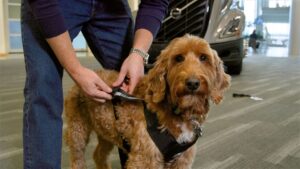Driver safety and risk mitigation are at a crossroads. The rapid evolution of artificial intelligence (AI) is equipping carriers with increasing options to employ technology into their safety programs.
But AI is only as intelligent as the humans who create and operate it. While AI is bringing more options to detect safety issues to carriers, the human element is still a vital component in analyzing the data AI provides.
AI alone is inefficient and ineffective in solving safety problems. The human factor must be incorporated into any AI program if safety is to be optimized.
“Ultimately we are all interested in protecting our brand, driving safely,” said Jeff Griswold, vice-president of operations for Solera Fleet Solutions, a company that works with motor carriers to incorporate technology into safety evaluations.
Video-Based Safety
The first aspect of AI in fleet operations has been used for many years — video-based safety. Carriers use external video to keep track of what happens in the minutes and seconds leading up to an incident or accident and to manage driver safety by identifying coachable moments.
“Video-based safety is an approach that utilizes a combination of video sensors and other inputs to help fleets identify driving skill, how safe vehicles are being operated and where safety leaders should emphasize skill improvement within their fleet,” Griswold said, adding that video also factors into liability and mitigation.
“It helps the fleet understand what led up to an incident and what happened so that they can manage the situation commensurate with their needs and the needs of the public,” he said.
Video-based safety deals with an aspect of AI known as “computer vision.” It strictly focuses on what’s happening in the driving environment outside the vehicle.
Driver Monitoring Systems
Where AI factors into the equation is in combining video-based safety with driver monitoring systems (DMS) that monitor what’s happening inside the truck’s cab. In many cases, DMS is another camera focusing on the activities of the driver coinciding with an incident recognized on external video.
DMS can help identify risk factors such as drowsy driving, a driver holding a mobile phone or a driver not wearing a seat belt.
The key to combining video-based safety with DMS is identifying an external event such as running a stop sign and analyzing the event within the context of what the driver is doing in the cab. Doing so without these tools takes tremendous amounts of time — time that could be better spent coaching drivers on safety violations and correcting their behavior.
“There’s an assessment of what is happening in that video, and that’s the critical factor here,” said Griswold. “AI is great for certain sensory inputs like warning the driver, maybe even creating and recording a video. But it’s that human element (that’s needed) to identify the broad spectrum of risk. And the thing about a human reviewer is that they can follow in a set of criteria and exceptions.”
The Human Factor
For a company like Solera Fleet Solutions, the goal is to inject the human element into the evaluation process.
“The video is generated, and workflows allocate it to review analysts,” Griswold said.
“The review analyst is trained to identify each of the individual elements of risk. They watch the video and listen to the audio,” he said. “At the same time, the analyst will look at the sensor inputs in combination with the video to determine each element of risk.”
Video analysis is a complicated process, and analysts typically spend six to eight weeks in the classroom before being approved to analyze real-time video and AI systems.
As an example, Griswold said, consider the driver who runs a stop sign. The video may flag passing through the stop sign as a violation, but the reviewer might recognize that the driver was waved through by construction personnel or law enforcement. In such a situation, no violation of safety occurred; however, without the human element, the distinction may not be made.
“It’s not a ‘gotcha!’ approach,” Griswold said. “What we’re attempting to do is to give fleets the data to work with drivers to improve skills. One important element of this is touching on the totality of the risk.”
The review analyst looks at everything happening in the video. For example, Solera analysts look for 80 safety markers or observations.
Carrier Responsibility
Sean Ritchie, vice-president of sales and engineering solutions for Solera notes that the best carriers realize that the company bears responsible for improving fleet safety.
“Ultimately, they wish they had more time — time in the day to really focus on those things that are actually the most risky,” Ritchie said.
In his experience, Ritchie says, 80% of the risk within a fleet is represented by 20% of the drivers.
“If you can find a way as a fleet safety manager to focus on those 20% of drivers, then you can actually mitigate the risk within your fleet” Ritchie said.
Make Time for Safety
But time is always an issue. Safety leaders have to identify the riskiest drivers and prioritize them for coaching.
Going back to the case of running a stop sign, a fleet manager may see two violations by two different drivers. However, human observation of the data may show that one driver simply didn’t see the stop sign … while the other driver committed six safety violations. Identifying that second driver as the priority for coaching is the information safety leaders need in order to improve overall fleet safety.
Of paramount importance, Ritchie says, fleets need to spend their time observing actual instances of violations.
Fleets can’t afford to waste time looking at videos that don’t show risky behavior. The challenge of relying on AI-only solutions is AI doesn’t have the ability to recognize risk — at least not yet. That human intelligence filter sitting on the backside is necessary if AI is to be efficient and effective.
“A human intelligence layer essentially fills in the gaps that are present and will be present in the near future when it comes to AI and fleet safety,” Ritchie said.
This story originally appeared in the May/June 2025 print edition of Truckload Authority, the official publication of the Truckload Carriers Association.
Since retiring from a career as an outdoor recreation professional from the State of Arkansas, Kris Rutherford has worked as a freelance writer and, with his wife, owns and publishes a small Northeast Texas newspaper, The Roxton Progress. Kris has worked as a ghostwriter and editor and has authored seven books of his own. He became interested in the trucking industry as a child in the 1970s when his family traveled the interstates twice a year between their home in Maine and their native Texas. He has been a classic country music enthusiast since the age of nine when he developed a special interest in trucking songs.















